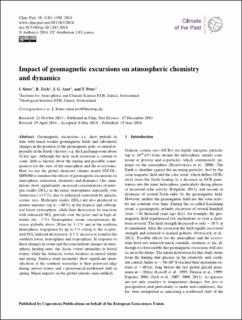Please use this identifier to cite or link to this item:
https://doi.org/10.21256/zhaw-4654| Publication type: | Article in scientific journal |
| Type of review: | Peer review (publication) |
| Title: | Impact of geomagnetic excursions on atmospheric chemistry and dynamics |
| Authors: | Suter, I. Zech, R. Anet, J. G. Peter, T. |
| DOI: | 10.21256/zhaw-4654 10.5194/cp-10-1183-2014 |
| Published in: | Climate of the Past |
| Volume(Issue): | 10 |
| Issue: | 3 |
| Page(s): | 1183 |
| Pages to: | 1194 |
| Issue Date: | Jun-2014 |
| Publisher / Ed. Institution: | Copernicus |
| ISSN: | 1814-9332 |
| Language: | English |
| Subject (DDC): | 551: Geology and hydrology |
| Abstract: | Geomagnetic excursions, i.e. short periods in time with much weaker geomagnetic fields and substantial changes in the position of the geomagnetic pole, occurred repeatedly in the Earth's history, e.g. the Laschamp event about 41 kyr ago. Although the next such excursion is certain to come, little is known about the timing and possible consequences for the state of the atmosphere and the ecosystems. Here we use the global chemistry climate model SOCOL-MPIOM to simulate the effects of geomagnetic excursions on atmospheric ionization, chemistry and dynamics. Our simulations show significantly increased concentrations of nitrogen oxides (NOx) in the entire stratosphere, especially over Antarctica (+15%), due to enhanced ionization by galactic cosmic rays. Hydrogen oxides (HOx) are also produced in greater amounts (up to +40%) in the tropical and subtropical lower stratosphere, while their destruction by reactions with enhanced NOx prevails over the poles and in high altitudes (by -5%). Stratospheric ozone concentrations decrease globally above 20 km by 1-2% and at the northern hemispheric tropopause by up to 5% owing to the accelerated NOx-induced destruction. A 5% increase is found in the southern lower stratosphere and troposphere. In response to these changes in ozone and the concomitant changes in atmospheric heating rates, the Arctic vortex intensifies in boreal winter, while the Antarctic vortex weakens in austral winter and spring. Surface wind anomalies show significant intensification of the southern westerlies at their poleward edge during austral winter and a pronounced northward shift in spring. Major impacts on the global climate seem unlikely. |
| URI: | https://digitalcollection.zhaw.ch/handle/11475/8911 |
| Fulltext version: | Published version |
| License (according to publishing contract): | CC BY 3.0: Attribution 3.0 Unported |
| Departement: | School of Engineering |
| Organisational Unit: | Centre for Aviation (ZAV) |
| Appears in collections: | Publikationen School of Engineering |
Files in This Item:
| File | Description | Size | Format | |
|---|---|---|---|---|
| 2014_Anet_Impact_of_geomagnetic_excursions.pdf | 1.4 MB | Adobe PDF |  View/Open |
Show full item record
Suter, I., Zech, R., Anet, J. G., & Peter, T. (2014). Impact of geomagnetic excursions on atmospheric chemistry and dynamics. Climate of the Past, 10(3), 1183–1194. https://doi.org/10.21256/zhaw-4654
Suter, I. et al. (2014) ‘Impact of geomagnetic excursions on atmospheric chemistry and dynamics’, Climate of the Past, 10(3), pp. 1183–1194. Available at: https://doi.org/10.21256/zhaw-4654.
I. Suter, R. Zech, J. G. Anet, and T. Peter, “Impact of geomagnetic excursions on atmospheric chemistry and dynamics,” Climate of the Past, vol. 10, no. 3, pp. 1183–1194, Jun. 2014, doi: 10.21256/zhaw-4654.
SUTER, I., R. ZECH, J. G. ANET und T. PETER, 2014. Impact of geomagnetic excursions on atmospheric chemistry and dynamics. Climate of the Past. Juni 2014. Bd. 10, Nr. 3, S. 1183–1194. DOI 10.21256/zhaw-4654
Suter, I., R. Zech, J. G. Anet, and T. Peter. 2014. “Impact of Geomagnetic Excursions on Atmospheric Chemistry and Dynamics.” Climate of the Past 10 (3): 1183–94. https://doi.org/10.21256/zhaw-4654.
Suter, I., et al. “Impact of Geomagnetic Excursions on Atmospheric Chemistry and Dynamics.” Climate of the Past, vol. 10, no. 3, June 2014, pp. 1183–94, https://doi.org/10.21256/zhaw-4654.
Items in DSpace are protected by copyright, with all rights reserved, unless otherwise indicated.